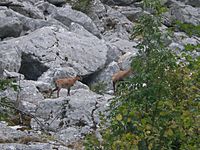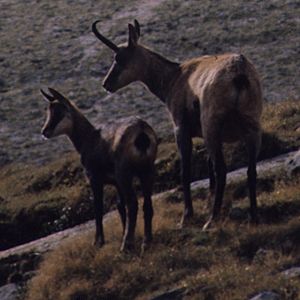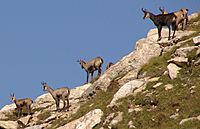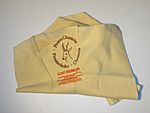Chamois facts for kids
Quick facts for kids Chamois |
|
|---|---|
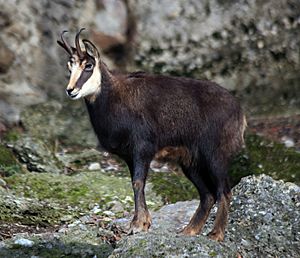 |
|
| At the Salzburg Zoo | |
| Conservation status | |
| Scientific classification | |
| Synonyms | |
|
Capra rupicapra Linnaeus, 1758 |
The chamois (pronounced sham-wah) is a type of goat-antelope. These amazing animals live in the mountains of Europe, from the west to the east. You can find them in places like the Pyrenees, the Alps, and the Carpathian Mountains. Chamois have also been brought to the South Island of New Zealand. Some types of chamois are very special and are protected by law in Europe.
Contents
What's in a Name?
The English name "chamois" comes from the French word chamois. This word might have come from an old Alpine language. Other languages also have similar names for this animal. For example, in German it's Gämse and in Italian it's camoscio.
When we talk about the animal, we usually say "sham-wah". But if you're talking about chamois leather, it's often pronounced "shammy". In New Zealand, people sometimes say "shammy" for the animal too. The word "chamois" stays the same whether you're talking about one animal or many.
Chamois Family Tree
Chamois belong to the Bovid family, which includes animals like sheep and goats. They are part of a group called goat-antelopes.
There are two main types of chamois in the Rupicapra family:
- R. rupicapra (this is the one we're talking about)
- R. pyrenaica (the Pyrenean chamois)
The R. rupicapra species has seven different kinds, called subspecies. They live in different parts of the world:
- R. r. asiatica (Anatolian or Turkish chamois): Found in Turkey.
- R. r. balcanica (Balkan chamois): Lives in countries like Albania, Bulgaria, and Greece.
- R. r. carpatica (Carpathian chamois): Found in Romania.
- R. r. cartusiana (Chartreuse chamois): Lives in France.
- R. r. caucasica (Caucasian chamois): Found in Azerbaijan, Georgia, and Russia.
- R. r. rupicapra (Alpine chamois): Lives in the Alps across countries like Austria, France, Germany, and Switzerland.
- R. r. tatrica (Tatra chamois): Found in Slovakia and Poland.
What Do They Look Like?
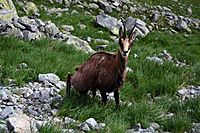
The chamois is a small animal. It stands about 70 to 80 centimeters (27 to 31 inches) tall. It measures about 107 to 137 centimeters (42 to 54 inches) long. Male chamois are a bit bigger, weighing 30 to 60 kilograms (66 to 132 pounds). Females weigh 25 to 45 kilograms (55 to 99 pounds).
Both males and females have short, straight horns. These horns hook backwards at the tips. Males have thicker horns. In summer, their fur is a rich brown color. In winter, it turns a lighter gray. Chamois have white patches on the sides of their heads. They also have clear black stripes below their eyes. A white patch on their rear and a black stripe down their back are also easy to spot.
Life in the Mountains
Female chamois and their young live together in groups. These groups can have up to 15 to 30 chamois. Adult males usually live alone for most of the year.
During mating season, which is in late November or early December in Europe, males fight to get the attention of females. After mating, a female chamois is pregnant for about 170 days. Usually, one baby chamois, called a kid, is born in May or early June. Sometimes, twins are born. If a mother chamois dies, other females in the group might try to raise the orphaned kid.
Baby chamois drink their mother's milk for about six months. They are fully grown by one year old. However, they don't have their own babies until they are three or four years old. Young males leave their mother's group when they become sexually mature. They wander around until they are old enough to have their own families, usually around eight or nine years old.
Chamois eat different plants. In summer, they eat grasses and herbs from the mountains. In winter, they eat pine trees, bark, and needles. They are usually active during the day. They often rest around midday. They might also look for food on moonlit nights.
Chamois can live up to 22 years in zoos. In the wild, they usually live 15 to 17 years. They can face dangers like avalanches and diseases. Humans are currently their main predators. In the past, animals like Eurasian lynxes and gray wolves also hunted them. Chamois are very fast. They can run up to 50 kilometers per hour (31 mph). They can jump 2 meters (6.5 feet) high or 6 meters (20 feet) far to escape danger.
Where Do Chamois Live?
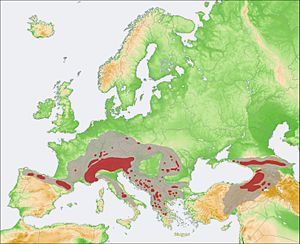
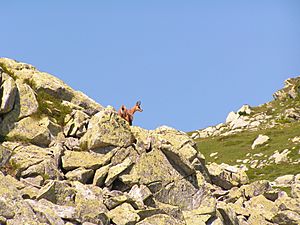
Chamois are originally from the Pyrenees mountains. They also live in the mountains of central and southern Europe, Turkey, and the Caucasus. They like to live in steep, rocky areas high up in the mountains, sometimes as high as 3,600 meters (11,800 feet).
In Europe, chamois spend their summers in grassy mountain fields above the tree line. But in winter, they move down to lower areas, around 800 meters (2,600 feet) high. There, they live in forests with lots of pine trees.
Chamois in New Zealand
Chamois arrived in New Zealand in 1907. They were a gift from the Austrian Emperor, Franz Joseph I. He sent two male and six female chamois. They traveled a long way by ship and train. The first chamois were released near the Aoraki / Mount Cook area. From there, they slowly spread across much of the South Island.
In New Zealand, hunting chamois is allowed and even encouraged. This helps to control their numbers. It also protects New Zealand's native mountain plants from being eaten too much by the chamois. Chamois in New Zealand tend to be a bit smaller than those in Europe. This might be because there is less food available for them.
Hunting and Management
Chamois meat is considered tasty, so they are popular animals for hunters. Hunters know two things about chamois that help them. First, chamois are most active in the morning and evening when they eat. Second, they tend to look for danger coming from below them. This means a hunter who approaches from above is less likely to be seen.
A special tuft of hair from the back of the chamois's neck is called a gamsbart. This "chamois beard" is a traditional decoration worn on hats in Alpine countries.
Chamois Leather
Chamois leather is very soft and can soak up a lot of liquid. It was traditionally made from the hide (skin) of a chamois. People like to use it for cleaning, buffing, and polishing because it won't scratch surfaces. Today, chamois leather can still be made from chamois hides. But it's also often made from the hides of deer, goats, or sheep.
Chamois Fabric
There is also a type of fabric called chamois. It is made from materials like cotton flannel or other similar fabrics. This fabric is brushed to make a soft, fuzzy surface. It feels a lot like moleskin or real chamois leather.
See also
 In Spanish: Rebeco de los Alpes para niños
In Spanish: Rebeco de los Alpes para niños




